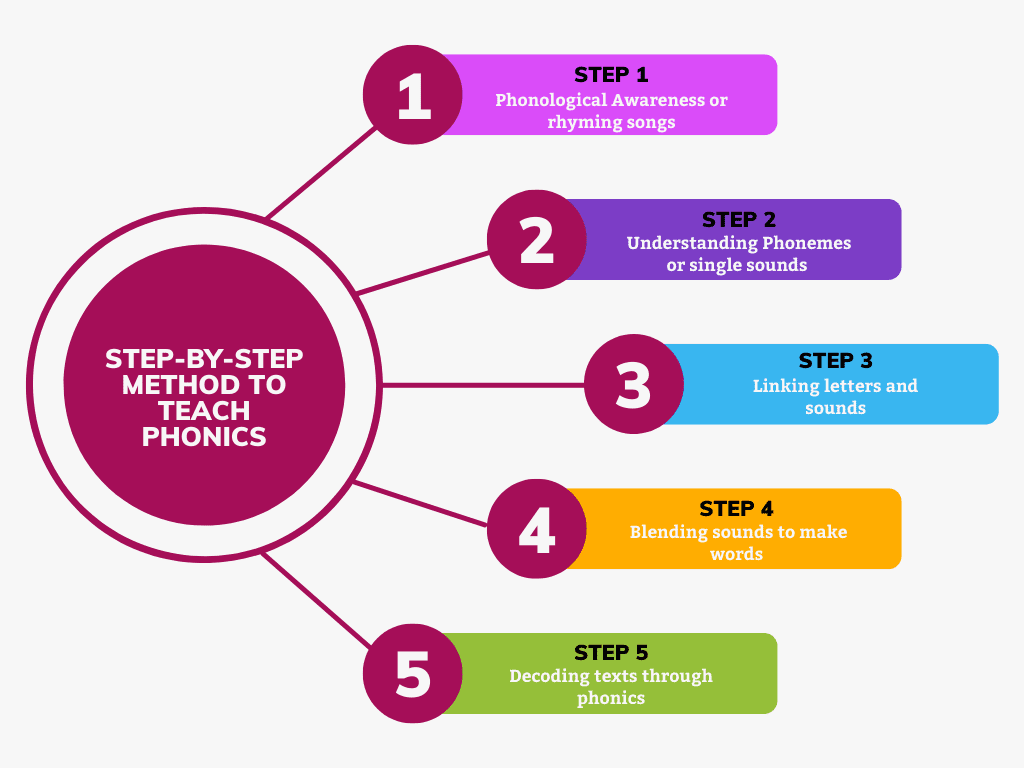
Helping your child learn to read might seem overwhelming, but teaching phonics at home doesn’t need to be complicated. Phonics is the foundation of reading skills, and with simple steps, you can make learning fun and effective. This guide will show you how to introduce phonics basics, set up a learning space, and use everyday activities to help your child succeed.
Understanding the Basics of Phonics
What Is Phonics and Why Is It Necessary?
Phonics connects sounds to printed letters. When children learn that each letter represents a specific sound, they can decode new words. This skill is key for reading fluency and confidence. Research shows that kids who get systematic phonics instruction tend to read better and faster. Unlike whole language approaches, phonics breaks reading into small, manageable parts, making it easier for beginners.
The Core Building Blocks of Phonics
- Letter-Sound Correspondence: Understanding that each letter makes a particular sound. For example, the letter “b” makes the “b” sound.
- Blending: Combining individual sounds smoothly to form words, like “c” + “a” + “t” to make “cat.”
- Segmenting: Breaking words into sounds, such as pulling apart “dog” into “d,” “o,” and “g.” This helps with spelling and decoding unfamiliar words.
Setting Up a Phonics-Friendly Learning Environment
Create a Calm, Organized Space
Choose a quiet corner free of distractions for learning time. Use a table or desk with easy access to your materials. Put up colorful alphabet charts and posters to reinforce letter and sound recognition. Keep the space inviting so your child looks forward to learning.
Gather Simple, Accessible Resources
Stock up on basic tools like:
- Flashcards with letters and pictures
- Magnetic or foam letter tiles
- Printable worksheets for practice
- Children’s picture books focusing on phonics
- Everyday items like beans, buttons, or small blocks for hands-on activities
Having these materials close by makes practice more engaging and spontaneous.
Step-by-Step Activities to Teach Letter-Sounds
Introducing Letters and Their Sounds
Start by focusing on a few letters at a time. Use tactile activities like tracing letters in sand or shaving cream. Say the sound aloud, then ask your child to repeat it. Connect each letter to an object: “b” for “ball,” “s” for “sun.” This helps link sounds to familiar items.
Fun Activities for Reinforcing Letter-Sound Relationship
For example, you can play a game called “Sou,” which uses simple words like “cow,” “sun,” and “bus.” Show a picture and ask your child to say the word, then identify the initial sound. Use letter tiles to spell out each word, reinforcing how sounds and letters match.
Songs, rhymes, and clapping games also add fun ways to memorize sounds and letters. Routine repetition helps solidify the connection.
Use Multi-Sensory Learning Tools
Touch and sight reinforce learning. Use sandpaper letters for kids to trace with their fingers. Play matching games where they pair pictures with starting sounds. These activities boost memory and make learning engaging.
Techniques for Teaching Blending and Segmenting
How to Teach Blending
Begin with simple sounds, like “c,” “a,” and “t.” Say each sound slowly, then invite your child to repeat and blend them into a word. For example, “c”—”a”—”t” sounds like “cat.” Use visual aids like picture cards to help them see the connection. Repetition builds confidence.
How to Teach Segmenting
Pick a word, such as “dog.” Say it aloud, then break it down into individual sounds: “d,” “o,” “g.” Clap or tap each sound to help your child hear the parts. Use counters or small objects to count the sounds together. This skill supports spelling and decoding.
Building Skills Gradually
Start with simple consonant-vowel-consonant (CVC) words. As they improve, introduce longer words and common digraphs like “sh” or “ch.” Patience and consistency are key in progressing smoothly.
Monitoring Progress and Adjusting Instruction
Spotting Signs of Success or Struggle
Watch for signs of what your child understands. Can they decode simple words easily? Do they confuse sounds or guess words by picture only? Notice if they’re confident or frustrated. Adjust activities if needed.
Supporting Growth and When to Seek Help
Review regularly with fun games and varied activities. Celebrate every small win to boost confidence. If your child struggles with decoding, consider consulting a reading specialist. Every child learns differently, and extra help can make a big difference.
Expert Tips and Resources
Educational experts agree early phonics instruction builds strong reading skills. For extra practice, try apps like “ABCmouse” or websites offering free printable phonics worksheets. Picture books with repetitive sounds strengthen learning. Link to printable activities and phonics games will keep your practice lively and effective.
Conclusion
Teaching phonics at home is all about patience, consistency, and making learning fun. Small, simple activities build a solid reading foundation. Celebrate progress, encourage curiosity, and watch your child’s confidence grow. With these tools and steps, you are well on your way to helping your child master the basics of reading and set them up for future success.


